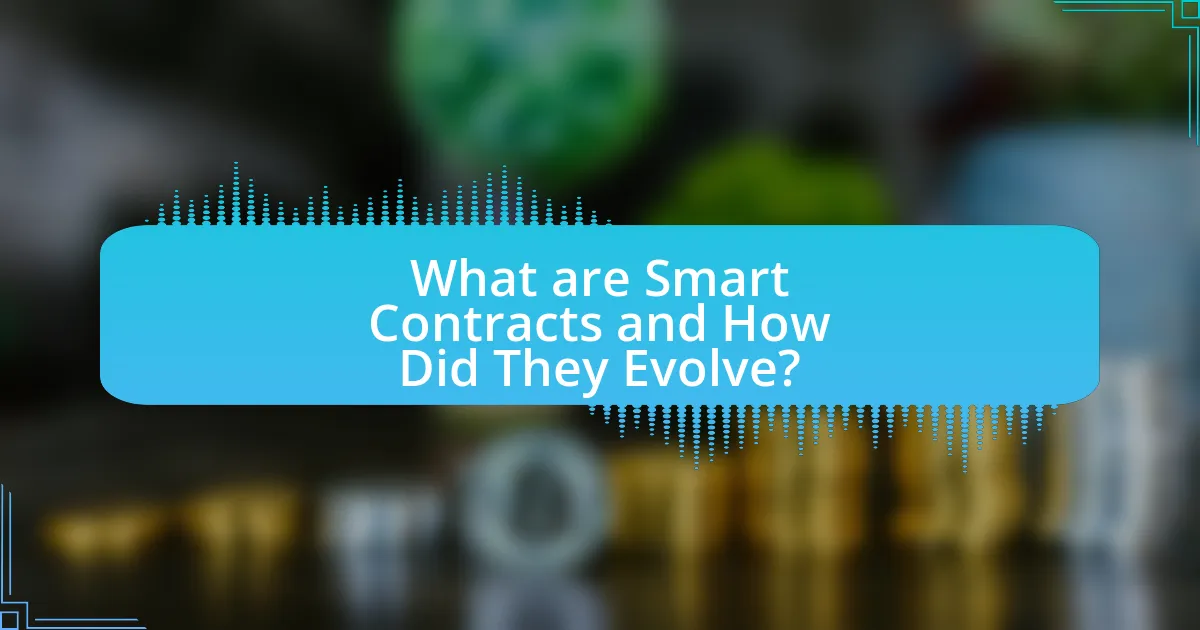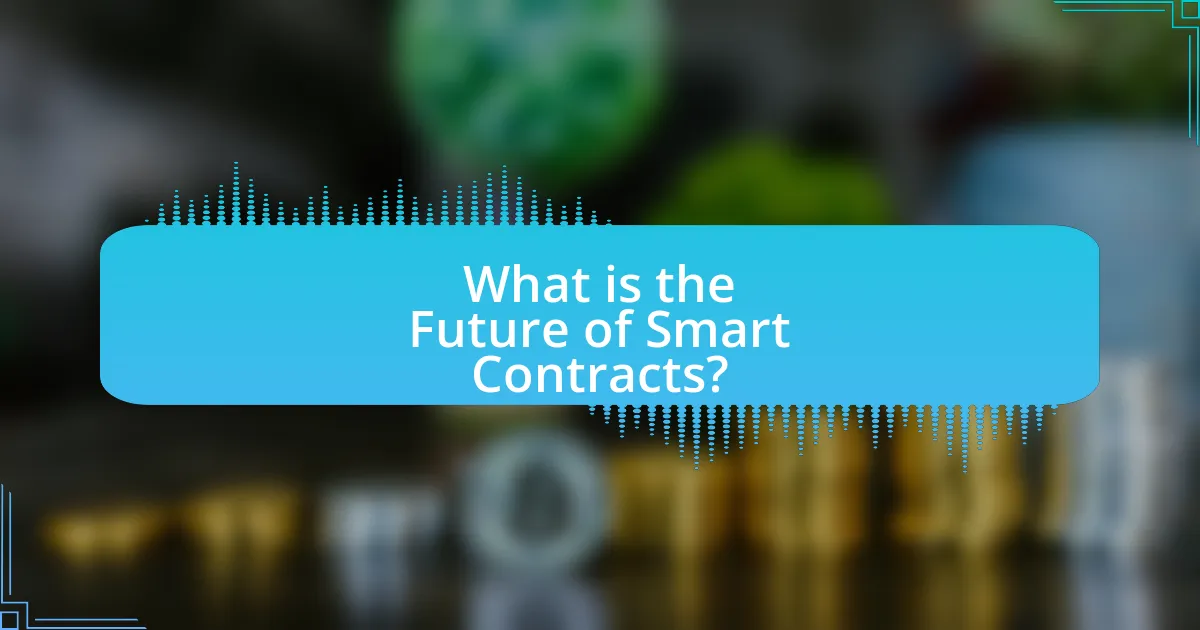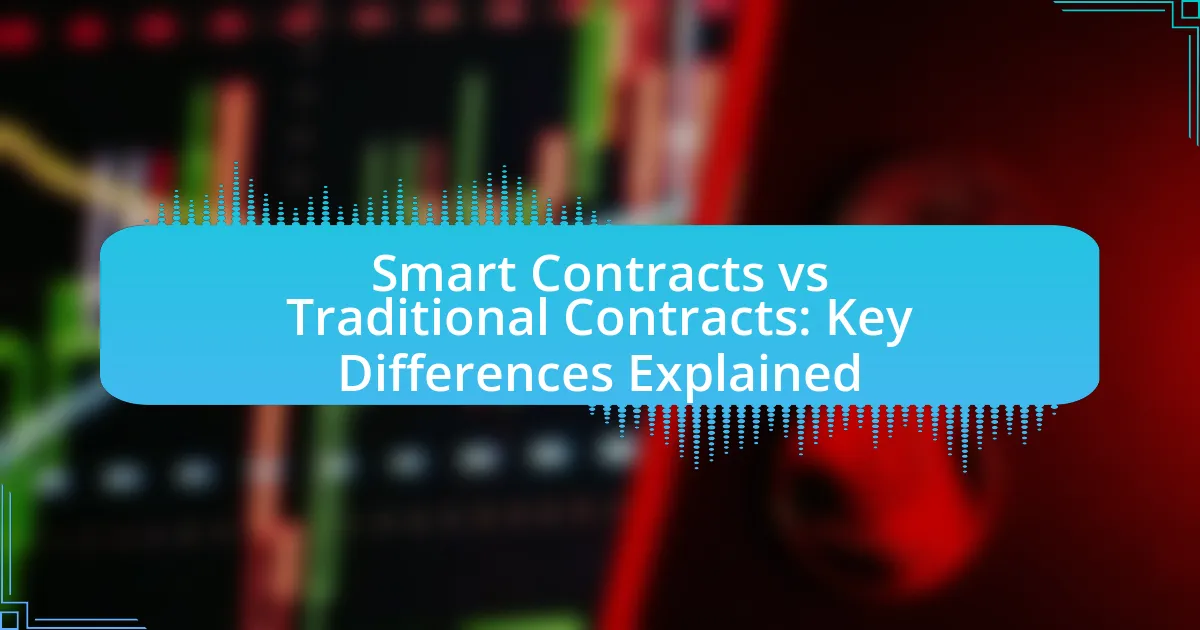Smart contracts are self-executing agreements with terms written in code, enabling automated transactions on blockchain networks. Initially conceptualized by Nick Szabo in 1994, their evolution accelerated with the launch of Ethereum in 2015, which allowed for the creation of decentralized applications. This article explores the definition, key features, and historical milestones of smart contracts, highlighting their differences from traditional contracts and their adoption across various industries such as finance, supply chain, and healthcare. Additionally, it examines the technical foundations, programming languages used, security vulnerabilities, and future trends that will shape the landscape of smart contracts.

What are Smart Contracts and How Did They Evolve?
Smart contracts are self-executing contracts with the terms of the agreement directly written into code, enabling automated and trustless transactions on blockchain networks. The concept was first introduced by computer scientist Nick Szabo in 1994, who envisioned digital contracts that could facilitate, verify, or enforce the negotiation or performance of a contract. The evolution of smart contracts gained significant momentum with the launch of Ethereum in 2015, which provided a platform for developers to create decentralized applications using smart contracts. This advancement allowed for more complex functionalities and broader applications beyond simple transactions, leading to their widespread adoption in various industries, including finance, supply chain, and real estate.
What is the definition of a smart contract?
A smart contract is a self-executing contract with the terms of the agreement directly written into code. This code is stored and executed on a blockchain, ensuring that the contract is immutable and transparent. Smart contracts automatically enforce and execute the terms when predetermined conditions are met, eliminating the need for intermediaries. The concept was first introduced by computer scientist Nick Szabo in 1994, who envisioned a digital protocol for facilitating, verifying, or enforcing the negotiation or performance of a contract.
How do smart contracts differ from traditional contracts?
Smart contracts differ from traditional contracts primarily in their execution and enforcement mechanisms. Traditional contracts require manual enforcement and interpretation by parties or legal systems, while smart contracts are self-executing agreements with the terms directly written into code on a blockchain. This automation reduces the need for intermediaries, minimizes the risk of human error, and enhances efficiency. For instance, a smart contract automatically executes transactions when predefined conditions are met, ensuring immediate compliance without external intervention. This fundamental difference in execution leads to increased transparency and security, as all transactions are recorded on a tamper-proof ledger.
What are the key features of smart contracts?
Smart contracts are self-executing contracts with the terms of the agreement directly written into code. Key features include automation, which eliminates the need for intermediaries, enhancing efficiency and reducing costs. They are immutable, meaning once deployed on a blockchain, the code cannot be altered, ensuring trust and security. Additionally, smart contracts are transparent, allowing all parties to view the contract terms and execution, which fosters accountability. Finally, they are decentralized, operating on blockchain technology, which enhances reliability and reduces the risk of single points of failure. These features collectively contribute to the growing adoption of smart contracts across various industries.
What historical milestones contributed to the evolution of smart contracts?
The evolution of smart contracts has been significantly influenced by several historical milestones, including the introduction of the concept by Nick Szabo in 1994, who defined smart contracts as self-executing contracts with the terms of the agreement directly written into code. This foundational idea laid the groundwork for later developments. In 2008, the release of Bitcoin by an anonymous entity known as Satoshi Nakamoto introduced blockchain technology, which provided a decentralized platform for executing smart contracts securely. The launch of Ethereum in 2015 further advanced smart contracts by enabling developers to create decentralized applications (dApps) using its Turing-complete programming language, allowing for more complex contract functionalities. These milestones collectively demonstrate the progression from theoretical concepts to practical implementations of smart contracts in various applications.
Who is credited with the initial concept of smart contracts?
Nick Szabo is credited with the initial concept of smart contracts. In 1994, Szabo introduced the term “smart contracts” in his paper titled “Smart Contracts: Building Blocks for Digital Markets,” where he outlined how contracts could be automated and executed through computer protocols. His work laid the foundational principles for the development of blockchain technology and decentralized applications, which utilize smart contracts today.
What technological advancements facilitated the development of smart contracts?
Blockchain technology is the primary technological advancement that facilitated the development of smart contracts. This decentralized ledger technology enables secure, transparent, and immutable record-keeping, which is essential for executing self-executing contracts without intermediaries. The introduction of Ethereum in 2015 further advanced smart contracts by providing a programmable blockchain that allows developers to create complex contractual agreements through its Turing-complete scripting language. Additionally, advancements in cryptographic techniques, such as public-key cryptography, ensure secure identity verification and transaction integrity, reinforcing the reliability of smart contracts. These technological innovations collectively support the functionality and adoption of smart contracts across various industries.
How have smart contracts been adopted across various industries?
Smart contracts have been adopted across various industries by automating processes, enhancing transparency, and reducing costs. In the financial sector, for instance, smart contracts facilitate automated trading and settlement processes, significantly decreasing transaction times and costs. The real estate industry utilizes smart contracts for property transactions, enabling secure and transparent transfers without intermediaries, which can reduce fraud and streamline the buying process. In supply chain management, companies implement smart contracts to track goods in real-time, ensuring compliance and improving efficiency by automating payment upon delivery confirmation. The healthcare sector employs smart contracts to manage patient data and consent, ensuring secure sharing of information while maintaining privacy. These implementations demonstrate the versatility and effectiveness of smart contracts in improving operational efficiency and trust across diverse sectors.
What industries are currently utilizing smart contracts?
Various industries are currently utilizing smart contracts, including finance, supply chain management, healthcare, real estate, and gaming. In finance, smart contracts automate transactions and enforce agreements, enhancing efficiency and reducing costs. The supply chain management sector uses smart contracts to track goods and ensure compliance with contractual obligations, improving transparency and accountability. In healthcare, smart contracts facilitate secure sharing of patient data and streamline billing processes. The real estate industry employs smart contracts for property transactions, simplifying the buying and selling process while ensuring secure and transparent transfers. Lastly, the gaming industry leverages smart contracts to create decentralized gaming platforms, enabling secure in-game transactions and ownership of digital assets.
How have smart contracts transformed business processes in these industries?
Smart contracts have transformed business processes across various industries by automating transactions and ensuring trust without intermediaries. In finance, for instance, smart contracts facilitate instant settlements and reduce transaction costs by eliminating the need for banks as intermediaries. In supply chain management, they enhance transparency and traceability, allowing all parties to access real-time data on product movement, which minimizes fraud and errors. The real estate sector benefits from smart contracts by streamlining property transactions, reducing paperwork, and expediting the transfer of ownership. According to a report by Deloitte, the implementation of smart contracts can reduce transaction costs by up to 30%, demonstrating their significant impact on operational efficiency and cost-effectiveness across these industries.

What are the Technical Foundations of Smart Contracts?
The technical foundations of smart contracts are primarily based on blockchain technology, which provides a decentralized and immutable ledger for executing and recording transactions. Smart contracts utilize programming languages, such as Solidity for Ethereum, to define the rules and conditions under which the contract operates. These contracts are executed by nodes in the blockchain network, ensuring transparency and security through consensus mechanisms like Proof of Work or Proof of Stake. The use of cryptographic techniques ensures the integrity and authenticity of the contract data, while decentralized storage allows for resilience against tampering.
How do smart contracts operate on blockchain technology?
Smart contracts operate on blockchain technology by executing predefined agreements automatically when specific conditions are met. These self-executing contracts are coded into the blockchain, ensuring that once deployed, they cannot be altered, which enhances security and trust. The decentralized nature of blockchain allows smart contracts to function without intermediaries, reducing costs and increasing efficiency. For instance, Ethereum, a leading blockchain platform, enables developers to create and deploy smart contracts using its programming language, Solidity, which facilitates complex transactions and interactions. This operational framework is validated by the fact that smart contracts have been utilized in various applications, such as supply chain management and financial services, demonstrating their effectiveness in automating processes and ensuring transparency.
What role does blockchain play in ensuring the security of smart contracts?
Blockchain plays a crucial role in ensuring the security of smart contracts by providing a decentralized and immutable ledger for their execution. This decentralized nature eliminates the risk of a single point of failure, as the contract’s code and transaction history are distributed across multiple nodes in the network. Additionally, the immutability of blockchain means that once a smart contract is deployed, its code cannot be altered, preventing unauthorized modifications that could compromise security. Furthermore, blockchain’s consensus mechanisms, such as proof of work or proof of stake, ensure that all participants agree on the validity of transactions, enhancing trust and reducing the likelihood of fraud. These features collectively contribute to the robustness and reliability of smart contracts in various applications.
How do consensus mechanisms affect smart contract execution?
Consensus mechanisms directly influence smart contract execution by determining how transactions are validated and agreed upon within a blockchain network. These mechanisms, such as Proof of Work or Proof of Stake, establish the rules for achieving agreement among nodes, which impacts the speed, security, and reliability of executing smart contracts. For instance, in a Proof of Work system, the computational effort required to validate transactions can lead to slower execution times compared to a Proof of Stake system, where validators are chosen based on their stake in the network, allowing for faster transaction processing. This difference in validation speed and method affects how quickly and efficiently smart contracts can be executed, ultimately influencing their usability and effectiveness in real-world applications.
What programming languages are commonly used for smart contract development?
The programming languages commonly used for smart contract development include Solidity, Vyper, and Rust. Solidity is the most widely used language, specifically designed for Ethereum smart contracts, enabling developers to write secure and efficient code. Vyper, also for Ethereum, emphasizes simplicity and security, making it suitable for developers focused on safety. Rust is utilized in projects like Polkadot and Solana, known for its performance and memory safety features. These languages are integral to the smart contract ecosystem, facilitating the creation of decentralized applications and blockchain solutions.
What are the advantages and disadvantages of these programming languages?
The advantages of programming languages used in smart contracts include strong security features, ease of use, and high efficiency, while the disadvantages encompass limited scalability, potential for bugs, and a steep learning curve. For instance, Solidity, a popular language for Ethereum smart contracts, offers robust security through its static typing and extensive testing frameworks, which help prevent vulnerabilities. However, its complexity can lead to bugs that are difficult to identify, and the Ethereum network itself faces scalability issues due to high transaction volumes. Additionally, languages like Vyper prioritize security and simplicity but may lack advanced features found in more established languages, limiting their functionality.
How does the choice of programming language impact smart contract functionality?
The choice of programming language significantly impacts smart contract functionality by influencing security, performance, and ease of development. For instance, Solidity, the primary language for Ethereum smart contracts, offers features tailored for blockchain applications, such as built-in support for complex data types and event logging, which enhances functionality and security. In contrast, languages like JavaScript may lack these specific features, potentially leading to vulnerabilities and inefficiencies in smart contract execution. Furthermore, the choice of language affects the developer community and available resources; for example, Solidity has a robust ecosystem with extensive documentation and libraries, facilitating faster development and deployment. This correlation between programming language and smart contract functionality is evident in the varying levels of adoption and success of different blockchain platforms, where those utilizing specialized languages tend to exhibit greater reliability and security in their smart contracts.
What are the challenges faced in the implementation of smart contracts?
The challenges faced in the implementation of smart contracts include technical complexity, legal recognition, and security vulnerabilities. Technical complexity arises from the need for precise coding and understanding of blockchain technology, which can lead to errors that compromise contract functionality. Legal recognition is a challenge because many jurisdictions have not yet established clear regulations governing smart contracts, creating uncertainty in their enforceability. Security vulnerabilities, such as coding bugs and susceptibility to hacking, pose significant risks, as evidenced by incidents like the DAO hack in 2016, where vulnerabilities in smart contract code led to the loss of $60 million in Ether. These challenges hinder widespread adoption and effective use of smart contracts in various industries.
What security vulnerabilities are associated with smart contracts?
Smart contracts are associated with several security vulnerabilities, including reentrancy attacks, integer overflow and underflow, and improper access control. Reentrancy attacks occur when a smart contract calls another contract and allows the second contract to call back into the first contract before the initial execution is complete, potentially leading to unexpected behavior. Integer overflow and underflow vulnerabilities arise when arithmetic operations exceed the maximum or minimum limits of data types, causing unintended consequences in calculations. Improper access control can lead to unauthorized users executing functions that should be restricted, compromising the integrity of the contract. These vulnerabilities have been highlighted in various incidents, such as the DAO hack in 2016, where a reentrancy attack resulted in the loss of $60 million worth of Ether, demonstrating the critical need for robust security measures in smart contract development.
How can developers mitigate risks when creating smart contracts?
Developers can mitigate risks when creating smart contracts by implementing thorough testing and auditing processes. Rigorous testing, including unit tests and integration tests, ensures that the contract functions as intended under various scenarios. Additionally, engaging third-party auditors to review the code can identify vulnerabilities and improve security. According to a report by ConsenSys, 70% of smart contracts contain vulnerabilities, highlighting the importance of these practices in reducing potential exploits.

What is the Future of Smart Contracts?
The future of smart contracts is poised for significant growth and integration across various industries. As blockchain technology matures, smart contracts will likely become more user-friendly and accessible, enabling widespread adoption in sectors such as finance, supply chain, and healthcare. According to a report by MarketsandMarkets, the smart contract market is projected to grow from $345 million in 2020 to $3.5 billion by 2026, reflecting a compound annual growth rate (CAGR) of 32.2%. This growth is driven by the increasing demand for automation, transparency, and security in transactions. Furthermore, advancements in interoperability between different blockchain platforms will enhance the functionality and applicability of smart contracts, allowing them to operate seamlessly across diverse ecosystems.
How are smart contracts expected to evolve in the coming years?
Smart contracts are expected to evolve significantly in the coming years through enhanced interoperability, improved scalability, and increased integration with artificial intelligence. Interoperability will allow smart contracts to function across multiple blockchain platforms, facilitating seamless transactions and data exchange. Improved scalability will address current limitations, enabling faster processing times and lower transaction costs, which are critical for widespread adoption. Additionally, the integration of artificial intelligence will enable smart contracts to execute more complex agreements autonomously, adapting to changing conditions in real-time. These advancements are supported by ongoing research and development in blockchain technology, as evidenced by initiatives like Ethereum 2.0 and the rise of cross-chain solutions.
What emerging technologies could influence the future of smart contracts?
Emerging technologies that could influence the future of smart contracts include artificial intelligence (AI), blockchain interoperability, and the Internet of Things (IoT). AI can enhance smart contracts by enabling automated decision-making and predictive analytics, which can improve contract execution and compliance. Blockchain interoperability allows different blockchain networks to communicate, facilitating the execution of smart contracts across various platforms, thereby increasing their utility and adoption. IoT devices can trigger smart contracts based on real-time data, enabling automated actions in response to specific conditions, such as supply chain management or energy distribution. These technologies collectively enhance the functionality, efficiency, and applicability of smart contracts in diverse sectors.
How might regulatory changes impact the adoption of smart contracts?
Regulatory changes can significantly impact the adoption of smart contracts by either facilitating or hindering their integration into existing legal frameworks. When regulations are clear and supportive, they can encourage businesses to adopt smart contracts by providing legal certainty and reducing perceived risks. For instance, jurisdictions that recognize smart contracts as legally binding, such as the state of Arizona in the United States, have seen increased interest and implementation of these technologies. Conversely, stringent regulations or a lack of clarity can deter adoption, as companies may fear legal repercussions or compliance challenges. The European Union’s proposed regulations on digital assets, which include provisions for smart contracts, illustrate how regulatory clarity can promote innovation while ensuring consumer protection.
What best practices should developers follow when creating smart contracts?
Developers should follow best practices such as thorough testing, code audits, and adherence to established standards when creating smart contracts. Thorough testing ensures that the contract behaves as expected under various conditions, reducing the risk of vulnerabilities. Code audits by independent experts help identify potential security flaws and improve the overall reliability of the contract. Adhering to established standards, such as ERC-20 for tokens, promotes interoperability and reduces the likelihood of errors. These practices are supported by the high-profile failures in smart contracts, such as the DAO hack in 2016, which resulted from inadequate testing and security measures.
How can developers ensure the security and efficiency of smart contracts?
Developers can ensure the security and efficiency of smart contracts by implementing rigorous testing, code audits, and utilizing formal verification methods. Rigorous testing involves using unit tests and integration tests to identify vulnerabilities and ensure that the contract behaves as expected under various conditions. Code audits, conducted by independent security experts, help uncover potential flaws and security risks that may not be evident to the original developers. Formal verification employs mathematical methods to prove the correctness of the contract’s logic, ensuring that it adheres to specified properties. These practices are supported by industry standards, such as the Ethereum Smart Contract Best Practices, which emphasize the importance of security measures in smart contract development.
What resources are available for learning about smart contract development?
Comprehensive resources for learning about smart contract development include online platforms, documentation, and community forums. Websites like Ethereum.org provide extensive documentation and tutorials specifically for Ethereum smart contracts, while platforms such as Coursera and Udemy offer structured courses on blockchain and smart contract programming. Additionally, GitHub hosts numerous open-source projects and code examples that can enhance practical understanding. Community forums like Stack Overflow and Reddit’s r/ethdev allow developers to ask questions and share knowledge, fostering a collaborative learning environment. These resources collectively support a robust learning experience in smart contract development.















